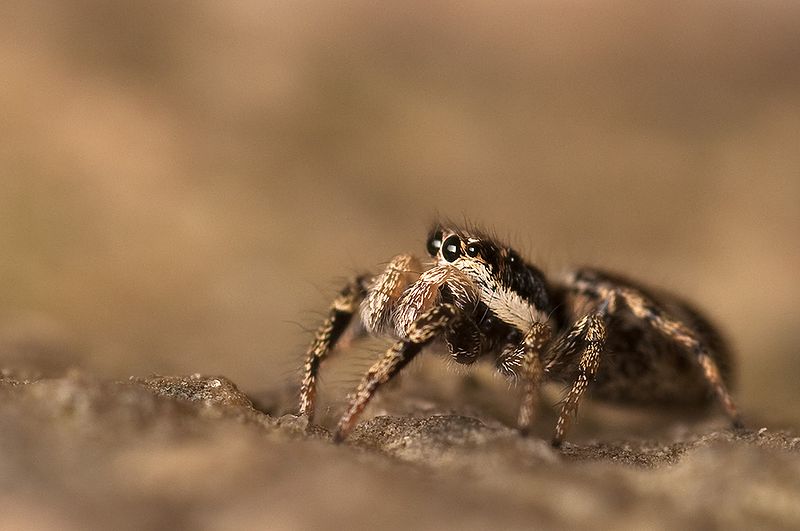Adaptations
"How
does the zebra spider move
?"
 Zebra
spiders actually jump
more than they walk. Zebra spiders have the ability to jump from
standing start. If that was not enough of an advantage over
their prey, they can
also jump backward and sideways with equal abilities. These types
of motions are used both to capture prey and to avoid capture by
predators. Whenever they jump, they will release thick, white,
slightly viscid silky line, to use as anchor position. There
are no extensor muscles at the 'hinge joints' of the spider leg,
Zebra
spiders actually jump
more than they walk. Zebra spiders have the ability to jump from
standing start. If that was not enough of an advantage over
their prey, they can
also jump backward and sideways with equal abilities. These types
of motions are used both to capture prey and to avoid capture by
predators. Whenever they jump, they will release thick, white,
slightly viscid silky line, to use as anchor position. There
are no extensor muscles at the 'hinge joints' of the spider leg,
 instead joints
extension is due to the haemocoelic blood pressure in the leg. The most significant evidence that this extension is due to
hydraulic forces is that the leg spines become erect during the
jump, a result of increased body pressure which can be
demonstrated on many other species of spiders as well. The zebra spider uses both the
third and fourth pair of legs when jumping, the third pair
leaving the ground after the fourth pair. Their Mean jumping velocity
is estimated to be between 64 and 79 cm/s.
instead joints
extension is due to the haemocoelic blood pressure in the leg. The most significant evidence that this extension is due to
hydraulic forces is that the leg spines become erect during the
jump, a result of increased body pressure which can be
demonstrated on many other species of spiders as well. The zebra spider uses both the
third and fourth pair of legs when jumping, the third pair
leaving the ground after the fourth pair. Their Mean jumping velocity
is estimated to be between 64 and 79 cm/s.
"What is the Zebra spider's
dominant sense?"
Zebra spider's dominant sense is sight, in
fact, the zebra spiders are considered to have the best vision
of any arthropod. They have acute vision
 with
distinctive eye arrangement of eight simple eyes that enable
them to focus in all directions. First median pair of eyes are
the largest,
located on front of cephalothorax,
look forward, and are called "headlight" eyes. Posterior eyes are
the smallest in size, located on top of cephalothorax and look
upward. Zebra spider's eyes can move in or out for focusing.
Also, their eyes can turn up and down, and left and right, for 360° eyesight (called "integral
binocular vision"). Zebra spider's nuclei of their retinal cells
in their anterior eyes
have, evolved to the side, out of the path of light. They can also turn
their carapace more than 45° to look around.
with
distinctive eye arrangement of eight simple eyes that enable
them to focus in all directions. First median pair of eyes are
the largest,
located on front of cephalothorax,
look forward, and are called "headlight" eyes. Posterior eyes are
the smallest in size, located on top of cephalothorax and look
upward. Zebra spider's eyes can move in or out for focusing.
Also, their eyes can turn up and down, and left and right, for 360° eyesight (called "integral
binocular vision"). Zebra spider's nuclei of their retinal cells
in their anterior eyes
have, evolved to the side, out of the path of light. They can also turn
their carapace more than 45° to look around.
"How does the Zebra spider breathe?"
Zebra spiders have two ways of breathing. First, breathes through
small holes in their abdomen called trachea holes. The trachea
is a hollow pipe that the spider breathes through, its windpipe.
The opening to the human trachea is our mouth and nose, whereas
the spider's trachea holes are on the underside of the abdomen
instead. A spider does not have lungs like humans do. The
trachea leads directly to the spider's internal organs. Second,
a spider absorbs oxygen through a structure called book lungs,
appropriately named because the organ is shaped like the pages of a
book. Blood flows inside the "pages" and exchanges oxygen from the
air circulating between them. These two structures vary among
spiders. Now that you are familiar with the zebra spider's adaptations,
learn about how they use it for nutrition.